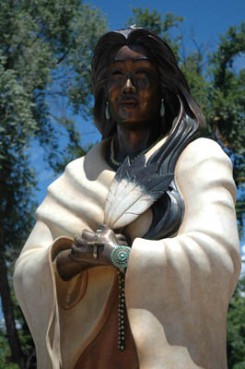
Blessed Kateri Tekakwitha (1656-1680) is honored by the Catholic Church as the patroness of ecology and the environment. Statue in front of St. Francis Cathedral, Santa Fe, New Mexico. RNS photo by Rene Shaw.
VATICAN CITY (RNS) A 17th-century Native American woman who cared for the sick and elderly, and a Catholic nun who worked with lepers in Hawaii, are on the verge of becoming the newest American saints, after Pope Benedict XVI certified miracles due to their intercession, the Vatican announced Monday (Dec 19).
The decrees concerned Kateri Tekakwitha and Mother Marianne Cope, both of whom had been declared “Blessed” by the late John Paul II. Each woman’s canonization still requires a papal bull, likely to come next year, calling for her veneration as a saint.
Tekakwitha was born in 1656 along the Mohawk River, in what is now New York state. Her father was a Mohawk chief and her mother an Algonquin woman who had converted to Catholicism. Tekakwitha suffered from smallpox at the age of 4, leaving her frail with impaired vision and facial scars.
After her baptism by a Jesuit missionary at age 20 drew strong disapproval from her family, Tekakwitha moved to a Christian community near Montreal. She later took a vow of chastity. The smallpox scars on her face are believed to have disappeared inexplicably a few minutes after her death.
John Paul waived the first miracle ordinarily required for Tekakwitha’s beatification in 1980.
According to Sister Kateri Mitchell, executive director of the Tekakwitha Conference in Great Falls, Mont., the miracle approved by Benedict on Monday concerns a 6-year-old Native American boy of the Lummi Reservation in Washington state, who was cured of a flesh-eating virus on his face in 2006, after Mitchell prayed with his family and placed a chip of Tekakwitha’s wrist bone on his body.
Mitchell, herself a member of the Mohawk nation, said Tekakwitha’s canonization would make her an official patron saint of Native Americans.
“This is what our people have been praying for all along,” Mitchell said. “The sacred circle of life of all cultures will be more complete because we will have been recognized by having one of our own as a saint in the universal church.”
Cope, a German-born Franciscan nun who spent 30 years caring for lepers on the island of Molokai, Hawaii, died of natural causes in 1918. She succeeded St. Damien de Veuster, a Belgian priest known as “Father Damien,” who died of leprosy in 1889. Damien, who was canonized in 2009, is considered the patron saint of Hawaii and of HIV/AIDS patients.
John Paul declared Cope “Blessed” in 2005, after recognizing as miraculous the 1993 cure of a teenage cancer patient in Syracuse, N.Y., who was dying of organ failure until a Franciscan nun prayed for Cope’s intercession. A second miracle, occurring after beatification, was required for her canonization.
Sister Grace Anne Dillenschneider, of the Syracuse-based Sisters of St. Francis of the Neumann Communities, said the order would not release details of Cope’s second miracle until Tuesday, but said the case concerned an unnamed woman on her deathbed whose recovery astonished the physicians treating her.




